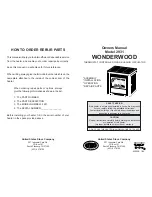
6
NOTE: DIAGRAMS & ILLUSTRATIONS ARE NOT TO SCALE.
CLEARANCES TO COMBUSTIBLES
WARNING: BE ABSOLUTELY SURE THE DISTANCE BETWEEN THE
HEATER AND THE SURFACE OF ANY COMBUSTIBLE CONSTRUCTION
IS NOT LESS THAN SHOWN IN THE FIGURES ON PAGE 7.
Floor Protection
USA
- The floor in front and under the heater must be protected with a
noncombustible material. The covering must extend 20” (508mm) in front
of the door opening of the heater and 8” to either side of the door opening.
Canada
- The floor in front and under the heater must be protected with
noncombustible material. The covering must extend 508 mm in front of
the door opening of the heater and 200 mm to either side of the stove
body and 200 mm to the rear or to the wall, whichever is smaller.
USA and Canada
- A chimney connector / venting extends horizontally
over the floor, protection must also cover the floor under the connector
/ venting and at least 2” (51 mm) to either side.
Alcove Clearances:
Minimum alcove width between combustible materials is 56-1/2”. Maxi-
mum alcove depth is 48”. Minimum alcove height is 72”.
Chimney and Connector
May only be installed using listed 6” or 8” double wall connector pipe
with UL103HT listed factory-built chimney suitable for use with solid
fuels or masonry chimney. Horizontal connections not tested, refer to
local building codes for installation. May be installed with 6” connector
pipe and chimney using an 8” to 6” reducer. See installation instructions
for details. Clearances to connector shall be measured from 8” flue collar.
Restrictions apply! Read instructions before installing.
This appliance may be installed using 6” chimney in vertical installations
utilizing a 8” to 6” reducer (cat. # 71134) at the flue collar. If the venting
system is all vertical and the total vent length above the flue outlet exceeds
14 feet, it is recommended that the 8” to 6” pipe reducer is used and a
6” venting system be installed.
This appliance may be vented into a code-approved masonry chimney
with flue liner.
WARNING: Chimney connector must be in good condition and kept
clean.
Do not install damaged parts.
Residential chimney systems must be from the same brands of double
wall pipe as listed for mobile homes.
All of the stove connector pipe used must be of the same brand. The
chimney that the stove pipe transitions into may be a different brand.
Other than the transition of the stove pipe into the chimney, do Not mix
different brand vent components. Install all vent components per vent
manufacturer’s instructions.
The chimney connector shall not pass through an attic or roof space,
closet or similar concealed space, or a floor, or ceiling. Where passage
through a wall, or partition of combustible construction is desired, the
installation shall conform to CAN/CSA-B365, Installation Code for Solid-
Fuel-Burning Appliances and Equipment.
There must be an effective vapor barrier at the location where the chimney
or other component penetrates to the exterior of the structure. Follow
the vent manufacturer's detailed instructions.
IMPORTANT NOTE:
See Draft Requirements and Selecting a Proper
Venting System on
Page 4
to assist you in choosing the proper venting
system for your installation.
Components Required For Installation
Legs AND bottom heat shield or pedestal.
Use all required components specified for this appliance. Do not
substitute.
WARNING: In the event that you remove the blower for any rea-
son, make sure a cover plate (available from IHP) is installed
before using the heater. Excessive rear wall temperatures will
result if the stove is burned without the cover plate.
NOTE: The
cover plate is not necessary if a blower has never been installed
because a knock-out will be in place to act as the cover.
Summary of Contents for Canyon ST310
Page 30: ...30 NOTES...







































